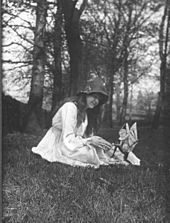Cottingley Fairies
The pictures came to the attention of writer Sir Arthur Conan Doyle, who used them to illustrate an article on fairies he had been commissioned to write for the Christmas 1920 edition of The Strand Magazine.Two months later the girls borrowed his camera again, and this time returned with a photograph of Elsie sitting on the lawn holding out her hand to a 1-foot-tall (30 cm) gnome.[6] One of the central beliefs of theosophy is that humanity is undergoing a cycle of evolution, towards increasing "perfection", and Gardner recognised the potential significance of the photographs for the movement: the fact that two young girls had not only been able to see fairies, which others had done, but had actually for the first time ever been able to materialise them at a density sufficient for their images to be recorded on a photographic plate, meant that it was possible that the next cycle of evolution was underway.Snelling's opinion was that "the two negatives are entirely genuine, unfaked photographs ... [with] no trace whatsoever of studio work involving card or paper models".Doyle contacted Gardner in June 1920 to determine the background to the photographs, and wrote to Elsie and her father to request permission from the latter to use the prints in his article.Arthur Wright was "obviously impressed" that Doyle was involved, and gave his permission for publication, but he refused payment on the grounds that, if genuine, the images should not be "soiled" by money.Several of the company's technicians examined the enhanced prints, and although they agreed with Snelling that the pictures "showed no signs of being faked", they concluded that "this could not be taken as conclusive evidence ... that they were authentic photographs of fairies".By this point, Frances was living with her parents in Scarborough,[16] but Elsie's father told Gardner that he had been so certain the photographs were fakes that while the girls were away he searched their bedroom and the area around the beck (stream), looking for scraps of pictures or cutouts, but found nothing "incriminating".I suggested only the most obvious and easy precautions about lighting and distance, for I knew it was essential they should feel free and unhampered and have no burden of responsibility.When our fairies are admitted other psychic phenomena will find a more ready acceptance ... We have had continued messages at seances for some time that a visible sign was coming through.To protect the girls' anonymity, Frances and Elsie were called Alice and Iris respectively, and the Wright family was referred to as the "Carpenters".[24] An enthusiastic and committed spiritualist, Doyle hoped that if the photographs convinced the public of the existence of fairies then they might more readily accept other psychic phenomena.[25] He ended his article with the words: The recognition of their existence will jolt the material twentieth-century mind out of its heavy ruts in the mud, and will make it admit that there is a glamour and mystery to life.[25]Early press coverage was "mixed",[26] generally a combination of "embarrassment and puzzlement";[27] though Japanese scholar Kaori Inuma has noted that there were also open and positive assessments.There is an extraordinary thing called Truth which has 10 million faces and forms – it is God's currency and the cleverest coiner or forger can't imitate it."I criticize the attitude of those who declared there is something supernatural in the circumstances attending to the taking of these pictures because, as a medical man, I believe that the inculcation of such absurd ideas into the minds of children will result in later life in manifestations and nervous disorder and mental disturbances.She admitted in an interview given that year that the fairies might have been "figments of my imagination", but left open the possibility she believed that she had somehow managed to photograph her thoughts.[20] BBC television's Nationwide programme investigated the case in 1971, but Elsie stuck to her story: "I've told you that they're photographs of figments of our imagination, and that's what I'm sticking to".[37] In a letter published in The Times newspaper on 9 April 1983, Geoffrey Crawley explained the discrepancy by suggesting that the photograph was "an unintended double exposure of fairy cutouts in the grass", and thus "both ladies can be quite sincere in believing that they each took it".In the same interview Frances said: "I never even thought of it as being a fraud – it was just Elsie and I having a bit of fun and I can't understand to this day why they were taken in – they wanted to be taken in.[40] Frances's daughter, Christine Lynch, appeared in an episode of the television programme Antiques Roadshow in Belfast, broadcast on BBC One in January 2009, with the photographs and one of the cameras given to the girls by Doyle.In one letter, dated 1983, Frances wrote: I hated those photographs from the age of 16 when Mr Gardner presented me with a bunch of flowers and wanted me to sit on the platform [at a Theosophical Society meeting] with him.









CottingleyBradfordSir Arthur Conan DoylefairiesThe Strand MagazineDaily ExpressNational Science and Media Museumphotographic plateCape TownTheosophical SocietyHarrogatespiritualistMagnus MagnussonIlfordphysicistpsychical researcherSir Oliver LodgeGloucestershiretheosophicalhammer pricebuyer's premiumScarboroughHarebellsMelbourneMaurice HewlettMargaret McMillanHenry De Vere StacpooleMajor John Hall-EdwardsGeoffrey HodsonNationwideAustin MitchellYorkshire Televisionscientific scepticJames RandiCommittee for the Scientific Investigation of Claims of the ParanormalGeoffrey CrawleyBritish Journal of PhotographyThe UnexplainedhatpinsThe Timesdouble exposureArthur C. Clarke's World of Strange PowersSherlock HolmeswatercoloursAntiques RoadshowBelfastBBC OnePaul AtterburyPhotographing FairiesTerry JonesBrian FroudA. J. ElwoodThe Cottingley CuckooThe SphereReverend George Vale OwenAtlas ObscuraStrand MagazineArthur C. ClarkeAnna FordFiona BruceTelegraph & ArgusPolidoro, MassimoDunning, BrianWikisourceProject GutenbergWayback MachineLibriVox